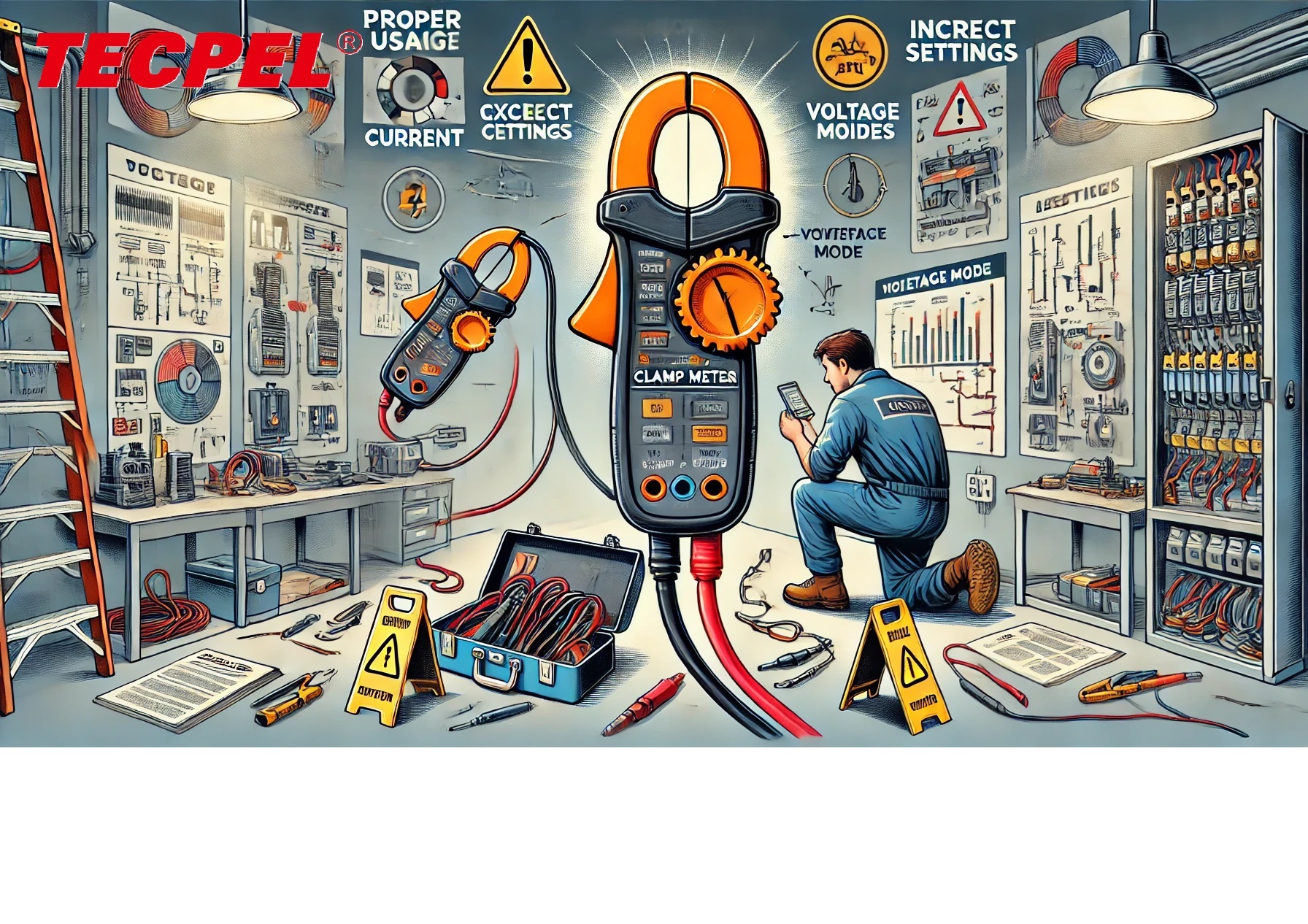Clamp meters tROUBLE SHOOTING TIPS
About Clamp meters

The Pro's Choice For Laboratory, Research, or Industry HVAC Quality Control.
The image depicts an electrician using a clamp meter to measure current on an HVAC system. He is wearing safety gear, including gloves and safety glasses, and is focused on the task. The background features various HVAC components such as air ducts, a furnace, and control panels, creating a realistic and professional setting.
Operational Principle of the Current Clamp Meter
The operational principle of the current clamp meter involves utilizing a silicon steel hook with at least 100 turns, enabling precise current measurement through its clamping mechanism without the need for direct contact or circuit interruption. When clamped onto a wire (e.g., AC power line), it serves as a current transformer with a conversion ratio of 1:100.
Through electronic rectification, the meter displays results by converting the magnetic field induced by the current into measurable electric current. This portable device, now referred to as a current clamp meter, integrates a current transformer and a current meter, allowing direct measurement of AC current without circuit disconnection.
The current clamp meter is a handheld device with multimeter functionality, capable of directly measuring AC/DC current without the need to disconnect the electrical conductor. Today's current clamp meters feature versatile designs and find widespread application in areas such as HVAC/R, electric vehicles, electrical installations, motor inspections, engineering, and more.
Primarily used for electrical maintenance, it not only provides current readings but can also measure voltage, resistance, and sometimes even frequency and capacitance, offering comprehensive functionality for troubleshooting and maintenance tasks.
The current clamp meter, renowned for its outstanding performance, practicality, and reliability, is highly favored by electrical engineers.
Correct Usage of Current Clamp Meter:
Essential Steps: Begin by connecting the AC/DC power cable. Hook onto one of the two lines. Adjust the ammeter to the appropriate gear position, such as DCM-033B 02/20A; 0200A/400A. Meaningful numbers will be generated for normal lines; if there is no display, it indicates an open circuit.
ac, dc current clamp meter key words
Keywords: Current clamp meter, HVAC/refrigeration, electric vehicle, electrical installation, motor testing, ground impedance hook meter, multimeter, AC, DC
The digital Clamp Meter is an electrical meter with integral AC current clamp. In order to use it properly, the normal usage is only one conductor passed through the probe
How to use curent clamp meter correctly?
Little knowledge:
1. Connect the AC/DC power cable first.
2. Hook one of the two lines.
3. Set the ammeter in the appropriate gear position such as DCM-033A 0~2/20A; 0~200A/ 400A
4. Normal lines will generate meaningful numbers; if no normal display indicates that the line is open.
Trouble shooting tips for Clamp meters

Clamp Meter Safety and Troubleshooting Guide: Avoiding Burnout and Handling Malfunctions
A clamp meter is a valuable tool for measuring current in a circuit without direct contact, but improper use can lead to serious damage, including burning out the meter. Below are common mistakes that can cause this and troubleshooting tips to keep your clamp meter functional.
How Clamp Meters Can Burn Out
A clamp meter can burn out if used incorrectly. Here are some typical reasons for this issue:
- Exceeding Current Limits: Every clamp meter has a rated maximum current it can handle. Measuring current beyond this rating can overload the device and cause internal components to burn out.
- Incorrect Settings: Using the wrong setting (e.g., measuring current when the meter is set to measure voltage) can lead to overloading the meter's circuitry.
- Prolonged Measurement of High Currents: Continuous measurement of high current for extended periods can cause the meter to overheat, potentially leading to internal damage.
- Measuring in Voltage Mode: If the meter is in voltage mode while trying to measure current, it can create a short circuit, leading to immediate damage.
- Direct Contact with Live Parts: Some clamp meters are designed to measure without direct contact, and improper handling with live wires can lead to short circuits, damaging the device.
Troubleshooting Common Clamp Meter Malfunctions
If your clamp meter malfunctions, follow these steps to troubleshoot:
- Check the Battery: A weak or dead battery can cause inaccurate readings or no readings at all. Replace the battery with a fresh one and test again.
- Inspect the Clamp Jaw: Dirt or debris on the clamp jaw can interfere with accurate current measurements. Clean the jaws with a dry cloth and check for damage.
- Test Continuity Function: If the continuity function is not working, check the internal fuse. A blown fuse can prevent proper operation, and replacing it may resolve the issue.
- Reset the Meter: Sometimes, a simple reset can resolve minor software glitches. Power the device off and back on, or remove and reinstall the battery to reset.
- Check Settings: Ensure the meter is set to the correct measurement mode. Misuse of settings is a frequent cause of incorrect readings.
- Verify Leads and Connections: If using test leads, inspect them for breaks or damage. Faulty leads can cause malfunctioning or erratic readings.
Preventing Clamp Meter Damage
To avoid damaging your clamp meter:
- Always read the manufacturer’s instructions.
- Ensure the meter's range and settings match the measurement task.
- Avoid prolonged exposure to high currents.
- Handle the clamp meter gently, especially the clamp jaw.
By the proper handling techniques and knowing how to troubleshoot, you can avoid damaging your clamp meter and extend its lifespan.
More Tecpel product Information:
Environment | Industrial Testers
Calibrators |Clamp transducer| Clamp Meters| DC Power Supplies| Electric Testers| Function Generators| LCR Meters/Instruments | Multimeters | Oscillosocpes | Oscilloscope Probes| Test Leads
Electric/Electronic Equipment
Anemometers | Calibrators| EMF field Testers | Infrared Thermometer | Light Meters /Manometers | Sound Level Meters| pH meters | Tachometers|Temp. and Humidity Meters | Temperature Humidity Transmitter | Temperature Calibrators| Thermocouples | Thermometers | Thickness Gauge |Accessoires
